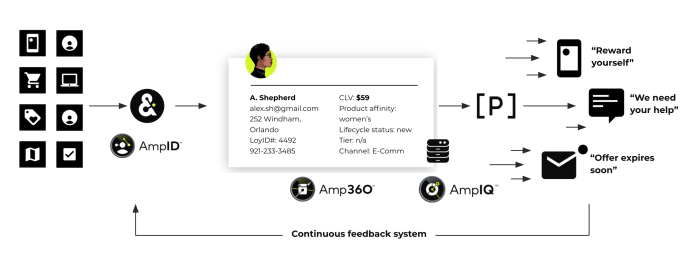Using Customer Data in Marketing dives into the world of data-driven marketing, where insights from customer data fuel innovative strategies and campaigns. From personalized marketing to targeted campaigns, this topic explores the power of leveraging customer data for success in the competitive marketing landscape.
Let’s take a deep dive into the realm of customer data and its pivotal role in shaping modern marketing practices.
Importance of Customer Data in Marketing: Using Customer Data In Marketing

Utilizing customer data in marketing strategies is crucial for businesses looking to connect with their target audience effectively. By leveraging customer data, companies can tailor their marketing campaigns to meet the specific needs and preferences of their customers, leading to higher engagement and conversion rates.
Enhancing Marketing Campaigns with Customer Data
Customer data can enhance marketing campaigns in various ways, such as:
- Creating personalized content: By analyzing customer data, businesses can create customized marketing materials that resonate with individual customers, increasing the likelihood of conversion.
- Targeted advertising: Using customer data, companies can target their ads to specific demographics or segments, resulting in more relevant and impactful marketing efforts.
- Improved customer experience: By understanding customer behavior and preferences through data analysis, businesses can provide a more personalized and seamless experience, leading to increased customer satisfaction and loyalty.
Impact of Personalized Marketing based on Customer Data
Personalized marketing based on customer data can significantly impact a company’s marketing success by:
- Increasing customer engagement: Personalized marketing messages resonate better with customers, leading to higher engagement rates and interactions with the brand.
- Boosting conversion rates: Tailoring marketing campaigns to individual preferences can result in higher conversion rates as customers are more likely to respond to personalized offers and recommendations.
- Building brand loyalty: By delivering personalized experiences, businesses can build stronger connections with customers, fostering loyalty and long-term relationships.
Types of Customer Data Used in Marketing

When it comes to marketing, there are various types of customer data that are crucial for understanding consumer behavior and creating effective strategies.
First-party Data vs. Third-party Data
First-party data is information collected directly from your customers, such as their purchase history, website interactions, and feedback. This data is reliable and specific to your business. On the other hand, third-party data is purchased from external sources and provides a broader view of consumer behavior across different platforms and industries.
Demographic Data
- Demographic data includes information such as age, gender, income, education level, and location. This helps marketers segment their target audience based on specific characteristics.
- For example, a company selling luxury goods may target consumers with a higher income level, while a children’s toy company may focus on parents with young children.
Psychographic Data, Using Customer Data in Marketing
- Psychographic data delves into the lifestyle, interests, values, and attitudes of consumers. This helps create more personalized marketing messages that resonate with the target audience.
- Understanding psychographic data can lead to the development of tailored marketing campaigns that connect emotionally with consumers based on their beliefs and preferences.
Behavioral Data
- Behavioral data tracks consumers’ actions, such as their browsing behavior, purchase history, and interactions with content. This data provides insights into consumer preferences and helps in predicting future behavior.
- By analyzing behavioral data, marketers can personalize recommendations, offers, and content to improve customer engagement and drive conversions.
Collection Methods for Customer Data
Companies employ various methods to collect customer data in order to enhance their marketing strategies and improve customer experiences.
1. Online Surveys
One common method used by companies is conducting online surveys to gather valuable feedback directly from customers. Surveys can help businesses understand customer preferences, opinions, and behavior patterns.
2. Website Tracking
Companies utilize tools like Google Analytics to track customer behavior on their websites. This data provides insights into how customers interact with the website, what pages they visit, and how long they stay, helping companies optimize their online presence.
3. Social Media Monitoring
Monitoring social media platforms allows companies to collect customer data from conversations, comments, and posts. This data can help businesses understand customer sentiments, preferences, and trends.
4. Loyalty Programs
Implementing loyalty programs enables companies to gather customer data through membership profiles and purchase histories. This information helps in personalizing marketing efforts and retaining loyal customers.
5. Point-of-Sale Data
Collecting data from point-of-sale systems provides companies with valuable information on customer purchases, preferences, and buying behavior. This data can be used to create targeted marketing campaigns and promotions.
Importance of Data Privacy and Compliance
It is crucial for companies to prioritize data privacy and comply with regulations such as GDPR and CCPA when collecting customer data. Ensuring the security and confidentiality of customer information builds trust and credibility with customers.
Examples of Successful Customer Data Collection Strategies
Companies like Amazon and Netflix have successfully implemented customer data collection strategies by leveraging personalized recommendations based on customer behavior and preferences. This has led to increased customer engagement and loyalty.
Utilizing Customer Data for Targeted Campaigns
When it comes to targeted marketing campaigns, customer data plays a crucial role in ensuring that the right message reaches the right audience at the right time. By leveraging the insights gained from customer data, businesses can create personalized and relevant campaigns that are more likely to resonate with their target customers.
Benefits of Segmenting Customers Based on Data Insights
Segmenting customers based on data insights allows businesses to tailor their marketing efforts to specific groups of customers with similar characteristics or behaviors. This approach offers several benefits, including:
- Increased Relevance: By targeting specific customer segments, businesses can deliver messages that are more relevant and personalized, increasing the likelihood of engagement.
- Higher Conversion Rates: When customers receive messages that resonate with their needs and preferences, they are more likely to take action, leading to higher conversion rates.
- Improved Customer Retention: By understanding the unique needs of different customer segments, businesses can provide better experiences, leading to increased customer loyalty and retention.
Examples of Successful Targeted Marketing Campaigns Using Customer Data
Several businesses have successfully utilized customer data to create targeted marketing campaigns that drive results. Here are a few examples:
Amazon: Amazon uses customer data to personalize product recommendations based on past purchases and browsing behavior, increasing the likelihood of conversions.
Sephora: Sephora segments customers based on their beauty preferences and purchase history to deliver personalized offers and recommendations, leading to higher engagement and sales.
Spotify: Spotify leverages customer data to create personalized playlists and recommendations, enhancing the user experience and driving user retention.